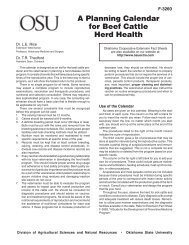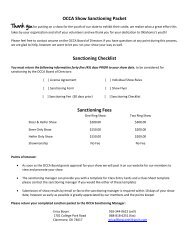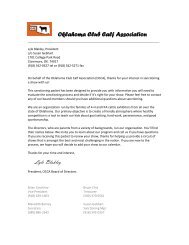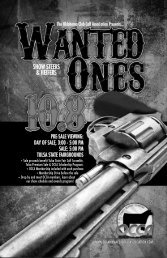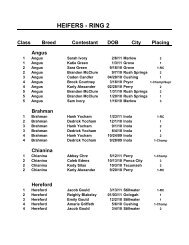Basics About Beef - the Oklahoma Club Calf Association
Basics About Beef - the Oklahoma Club Calf Association
Basics About Beef - the Oklahoma Club Calf Association
Create successful ePaper yourself
Turn your PDF publications into a flip-book with our unique Google optimized e-Paper software.
TIMETABLE For cooking in a conventional oven<br />
18 The degree of doneness<br />
can be easily determined by<br />
measuring <strong>the</strong> internal temperature<br />
of a cut of meat. To do so, use an<br />
ovenproof meat <strong>the</strong>rmometer.<br />
Insert <strong>the</strong> <strong>the</strong>rmometer into <strong>the</strong> roast at a slight<br />
angle so that <strong>the</strong> tip of <strong>the</strong> <strong>the</strong>rmometer is in <strong>the</strong><br />
thickest portion of <strong>the</strong> meat, but not resting in fat<br />
or against bone. Since <strong>the</strong> potentially harmful<br />
bacteria that might be present are typically on <strong>the</strong><br />
surface of <strong>the</strong> beef cut, do not remove and reinsert<br />
<strong>the</strong> <strong>the</strong>rmometer without first washing it in hot<br />
soapy water. In general, beef should be cooked to<br />
an internal temperature of 145°F (medium rare),<br />
160°F (medium) or 170°F (well done). To avoid<br />
overcooking, remember to remove a roast from <strong>the</strong><br />
oven when <strong>the</strong> <strong>the</strong>rmometer reads 5° to 10°F below<br />
<strong>the</strong> desired degree of doneness. As <strong>the</strong> roast sits before<br />
carving, its temperature will rise an additional 5° to<br />
10° F. If you use an instant<br />
read <strong>the</strong>rmometer, do<br />
not leave it in <strong>the</strong><br />
roast during<br />
cooking. Follow<br />
manufacturer<br />
instructions.<br />
DRY HEAT<br />
Approximate<br />
ROASTING Approximate Oven<br />
Total Cooking Time 1<br />
Weight Temperature Medium Rare Medium<br />
Primal Retail Cut (pounds) (degrees F) (145°F) (160°F)<br />
RIB Ribeye Roast (small end) 3 to 4 350 1 /2 to 1 3 /4 hours 1 3 /4 to 2 hours<br />
4 to 6 350 1 3 /4 to 2 hours 2 to 2 1 /2 hours<br />
6 to 8 350 2 to 2 1 /4 hours 2 1 /2 to 2 3 /4 hours<br />
8 2 to 10 2 325 2 1 /2 to 3 1 /4 hours 3 to 3 3 /4 hours<br />
Ribeye Roast (large end) 3 to 4 350 1 3 /4 to 2 1 /4 hours 2 to 2 1 /2 hours<br />
4 to 6 350 2 to 2 1 /2 hours 2 1 /2 to 3 hours<br />
6 to 8 350 2 1 /4 to 2 1 /2 hours 2 3 /4 to 3 hours<br />
Rib Roast (chine bone removed) 4 to 6 (2 ribs) 350 1 3 /4 to 2 1 /4 hours 2 1 /4 to 2 3 /4 hours<br />
6 to 8 (2 to 4 ribs) 350 2 1 /4 to 2 1 /2 hours 2 3 /4 to 3 hours<br />
8 to 10 (4 to 5 ribs) 350 2 1 /2 to 3 hours 3 to 3 1 /2 hours<br />
LOIN Tenderloin Roast (well-trimmed) 2 to 3 (center-cut) 425 35 to 40 minutes 45 to 50 minutes<br />
4 to 5 (whole) 425 50 to 60 minutes 60 to 70 minutes<br />
Tri-Tip Roast 1 /2 to 2 425 30 to 40 minutes 40 to 45 minutes<br />
ROUND Round Tip Roast (cap off) 3 to 4 325 1 3 /4 to 2 hours 2 1 /4 to 2 1 /2 hours<br />
4 to 6 325 2 to 2 1 /2 hours 2 1 /2 to 3 hours<br />
6 to 8 325 2 1 /2 to 3 hours 3 to 3 1 /2 hours<br />
8 2 to 10 2 325 3 to 3 3 /4 hours 3 3 /4 to 4 1 /2 hours<br />
Top Round Roast 6 to 8 325 2 1 /2 to 3 hours —<br />
8 2 to 10 2 325 3 to 3 3 /4 hours —<br />
Eye Round Roast 2 to 3 325 1 /2 to 1 3 /4 hours —<br />
Rump Roast 3 to 4 325 1 /2 to 2 hours —<br />
Bottom Round Roast 3 to 4 325 1 /2 to 2 hours —<br />
OTHER Meatloaf (8” x 4”) 1 /2 350 — 1 /4 hours<br />
1 Based on meat removed directly from refrigerator.<br />
2 Tent loosely with aluminum foil halfway through roasting time.<br />
3 Marinate.



